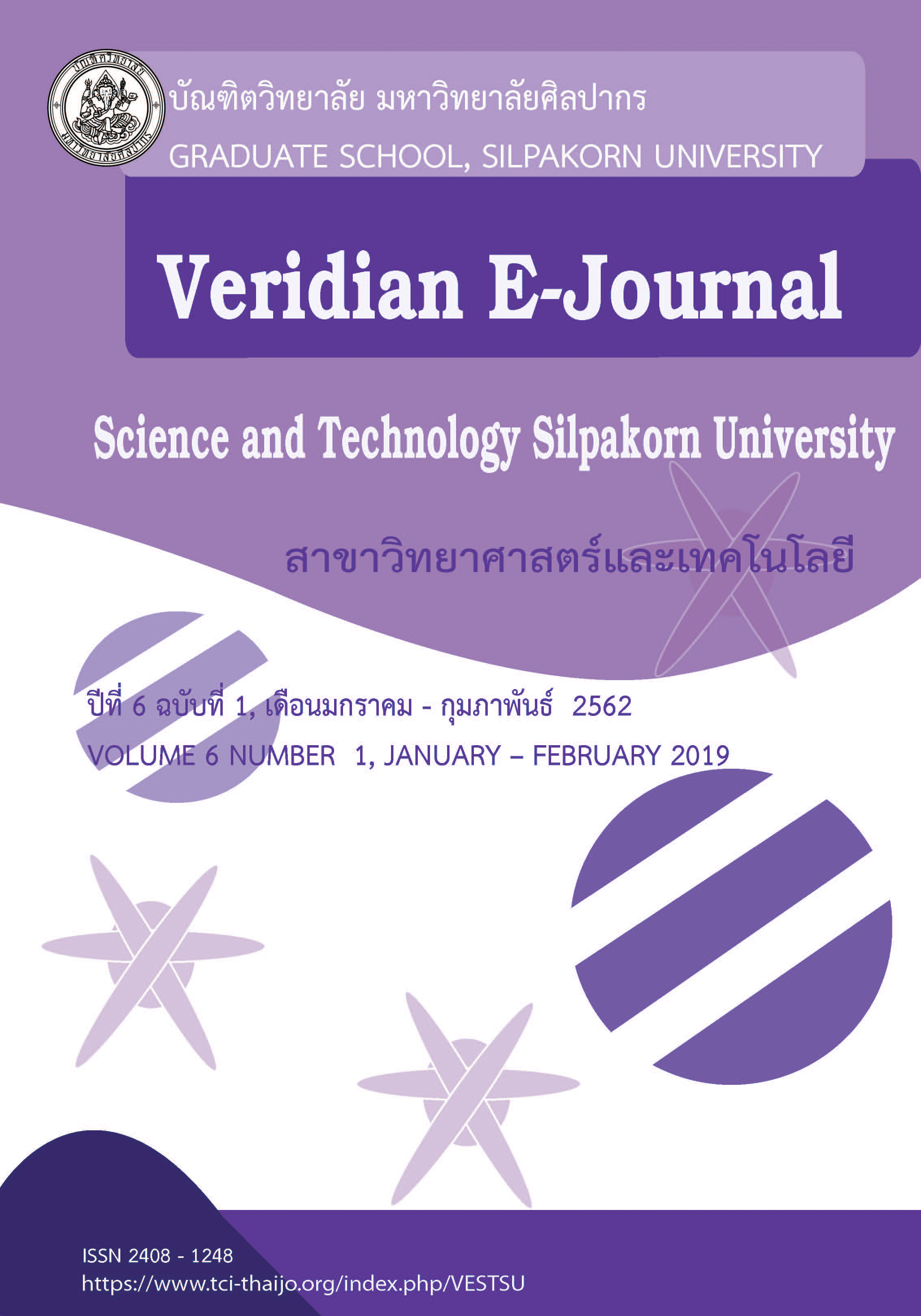การพัฒนาระบบควบคุมอุณหภูมิและความชื้นในโรงเรือนเพาะเห็ด โดยอาศัยเซนเซอร์ตรวจวัดอากาศร่วมกับระบบพลังงานแสงอาทิตย์ (Development of Temperature and Humidity Control System for Mushroom House by using Air Sensors and Solar-Powered System)
Main Article Content
Abstract
งานวิจัยนี้เป็นการพัฒนาระบบควบคุมอุณหภูมิและความชื้นในโรงเรือนเพาะเห็ดโดยอาศัยเซนเซอร์ตรวจวัดอากาศร่วมกับระบบพลังงานแสงอาทิตย์ โดยผู้วิจัยได้ออกแบบ ติดตั้ง และทดสอบประสิทธิภาพของอุปกรณ์กับฟาร์มเห็ดของกลุ่มเกษตรกรในตำบลหนองปากโลง อำเภอเมือง จังหวัดนครปฐม ด้วยการเพาะเห็ดจำนวน 760 ก้อน เป็นระยะเวลาสองรอบการผลิต คือรอบแรกในเดือนสิงหาคมถึงเดือนตุลาคม พ.ศ. 2559 และรอบที่สองในช่วงเดือนธันวาคม พ.ศ. 2559 ถึงกุมภาพันธ์ พ.ศ.2560 ผู้วิจัยได้เก็บข้อมูลผลผลิต ไม่ว่าจะเป็นน้ำหนักของดอกเห็ดของก้อนเห็ดแต่ละก้อนในแต่ละวัน ข้อมูลอุณหภูมิและความชื้น ตลอดจนการเปิดปิดระบบควบคุมในโรงเรือนควบคุมอัตโนมัติ และพบว่าในช่วงเดือนสิงหาคมถึงเดือนตุลาคม พ.ศ. 2559 ก้อนเห็ดของโรงเรือนควบคุมอัตโนมัติและโรงเรือนที่ไม่มีการควบคุมให้ปริมาณผลผลิตใกล้เคียงกัน โดยต่างกันเพียง 0.67 % เนื่องจากเป็นช่วงฤดูฝนความชื้นในโรงเรือนจึงสูงอยู่เสมอ ส่วนในช่วงเดือนธันวาคม พ.ศ. 2559 ถึงกุมภาพันธ์ พ.ศ.2560 ปริมาณผลผลิตของก้อนเห็ดในทั้งสองโรงเรือนจะน้อยกว่าในช่วงฤดูฝน โดยในโรงเรือนควบคุมอัตโนมัติจะให้ผลผลิตที่มากกว่าที่ประมาณ 14.72 % ซึ่งเป็นข้อดีที่จะทำให้เกษตรกรลดการหยุดการเพาะเห็ดในหน้าแล้งเนื่องจากปัญหาผลผลิตต่ำ
นอกจากนี้ ผู้วิจัยได้ทำการวิเคราะห์ต้นทุนและผลตอบแทนจากการใช้ระบบพลังงานแสงอาทิตย์ โดยพิจารณาจากต้นทุนค่าวัสดุและค่าจ้างในการติดตั้งระบบพลังงานแสงอาทิตย์สามารถสรุปได้ว่าหากมองที่ระยะเวลาคุ้มทุนแล้วระบบพลังงานแสงอาทิตย์สำหรับการควบคุมอุณหภูมิและความชื้นในโรงเรือนเพาะเห็ดยังไม่คุ้มค่ากับการลงทุน แต่หากเป็นการใช้งานในพื้นที่ที่ยังไม่มีไฟฟ้าเข้าถึง และต้องมีค่าใช้จ่ายในการขยายเขตระบบไฟฟ้าหลายหมื่นถึงหลายแสนบาทก็ถือว่าเป็นการลงทุนที่คุ้มค่าเป็นอย่างมาก
This research is to develop a temperature and humidity control system in a mushroom house by using sensors and solar energy. We installed and tested the efficiency of the equipment in a mushroom farm of Nong-Pak-Long farmer group in Muang District, Nakhon Pathom Province with 760 mushrooms for two production cycles. The first round was in August to October 2016 and the second round was from December 2016 to February 2017. We collected the weight of each mushroom, temperature, humidity the system control logs and found that during August to October 2016, the mushrooms of both houses gave very good and similar yields with only 0.67% difference because it was in the rainy season; the humidity in the house is always high. But during December 2016 to February 2017, the yield of mushrooms in both houses was less than the yield in the rainy season and the automatic control house have 14.72% higher yield than the manual control house. This result is a good way to reduce the number of farmers who give up mushroom cultivation in dry season because of low production yield.
In addition, we analyzed the costs and benefits of using solar energy by considering cost of materials and wages for installing solar systems and found that the payback time of using the solar system for controlling the temperature and humidity in a mushroom house is not worth the investment. But using this system in areas where electricity is not available and high cost of expanding the power grid is about several ten thousand to several hundred thousand baht is considered a very worthwhile investment.

